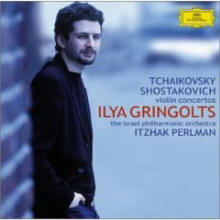|
You are reading the older HTML site Positive Feedback ISSUE march/april 2008
Tchaikovsky Violin Concerto in D, Op. 35 It's hard to get a fix on Ilya Gringolts here. His playing is capable, musical and animated—he isn't just another conservatory clone without a personality. Yet he lacks a strong tonal profile—there's nothing especially memorable about his sound as such—so that one ends up mostly noticing what's missing: we don't hear the soaring purity, say, of Chung (Decca) or Accardo (Philips), the rich sound of Perlman (EMI), or, in the passagework, the pinpoint intonation of Heifetz (RCA). Save for the novelty inherent in Itzhak Perlman's assuming the podium in support of an up-and-coming colleague, this Tchaikovsky is essentially superfluous—creditable but lacking the fresh insights that would justify permanent documentation. The leisurely first movement—increasingly the fashionable approach, but difficult to bring off, especially for those of us weaned on Heifetz's taut stereo account—and Canzonetta are mostly uneventful. The Finale is better, deft and energetic, though Gringolts' runs are a bit scratchy and approximate, and some of the harmonics fall shy of pitch. I don't know how good Perlman's conducting is—at least as far as the actual baton waving goes—but, having appeared with the Israel Philharmonic as soloist on numerous occasions, he undoubtedly has a strong personal and musical rapport with them. They play well for him, with the orchestral part in the Finale coming particularly to life The less familiar Shostakovich concerto—less familiar to me, at any rate—leaves a better impression. Gringolts understands what the piece should hould sound like, at least, narrowing the vibrato to produce a thinner, "threadier" tone appropriate to this brooding music. But the two slow movements progress in short segments rather than broad arches; it's odd to hear the busy, incisive Scherzo unfolding in longer lines than the opening Nocturne! The orchestra sounds a bit tentative here; the effect, while perhaps not entirely intentional, is suitable. Perlman has a good feel for the motor rhythms of the two fast movements, however, and he builds the Passacaglia with a steady intensity that renders it fully worthy to stand with the analogous slow movement of the Fifth Symphony. Stephen Francis Vasta
|

